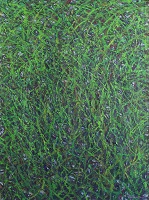Ampelio Tettamanti's Entanglements
There are artists who will forever be associated with a given current, period or era, although their artistic production exceeds those reasonable and legitimate borders.
 This applies to the case of Ampelio Tettamanti. Reflecting on his paintings means engaging with social realism, of which he was a protagonist. Yet in later years (before his early demise at age of forty-seven in 1961) he gave life to an intense cycle of works which pointed toward informal art, although always through a naturalistic approach.
This applies to the case of Ampelio Tettamanti. Reflecting on his paintings means engaging with social realism, of which he was a protagonist. Yet in later years (before his early demise at age of forty-seven in 1961) he gave life to an intense cycle of works which pointed toward informal art, although always through a naturalistic approach.
In fact, his 'Woods' cycle of paintings is affected by the then widespread influence of abstract expressionism, Pollock especially, whose art had been shown in Milano by the Galleria del Naviglio, his first personal exhibit in Italy, as early as 1950.
We are only speaking about formal affinity, of course. In Tettamanti, the interweaving of lines always maintains naturalistic references: his woods are, indeed, entanglements of branches.
They do not express the aimless wandering of what, not by chance, became known as Action Painting and associated with existentialist philosophy.
"In Action Painting" says art critic Elena Pontiggia, "the artwork is no longer representation but becomes pure gesture, a testimony of existence. Conversely, in Tettamanti the tangles of tree branches, through which the light filters only with difficulty, remain metaphors of the hardness of living, of the infinite knots of existence. They are thickly tangled, not devoid of thorns, but in the distance we can glimpse a light: it's the light the artist had always tried to indicate, as he painted the labors of everyday life".
Organized by ISU Bocconi
Free entrance, Monday-Friday 9 am – 12 pm, from 7 May to 22 June 2018